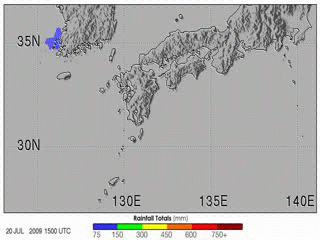Fail:Heavy Rains in Southern Japan.gif
Penampilan
Heavy_Rains_in_Southern_Japan.gif (320 × 240 piksel, saiz fail: 8.35 MB, jenis MIME: image/gif, berulang, 268 bingkai, 8.0 s)
Sejarah fail
Klik pada tarikh/waktu untuk melihat rupa fail tersebut pada waktu itu.
| Tarikh/Waktu | Gambar kenit | Ukuran | Pengguna | Komen | |
|---|---|---|---|---|---|
| semasa | 21:56, 31 Julai 2009 |  | 320 × 240 (8.35 MB) | Originalwana | {{Information |Description={{en|1=The 2009 summer monsoon brought torrential rains to south western Japan in July. This animatin shows rainfall estimates for southern Japan and the surrounding region from July 20–27. The most prominent feature is a larg |
Penggunaan fail
Laman berikut menggunakan fail ini:
Penggunaan fail sejagat
Fail ini digunakan oleh wiki-wiki lain yang berikut:
- Penggunaan di cs.wikipedia.org
- Penggunaan di en.wikipedia.org
- Penggunaan di fi.wikipedia.org
- Penggunaan di id.wikipedia.org
- Penggunaan di ja.wikipedia.org
- Penggunaan di si.wikipedia.org
- Penggunaan di te.wikipedia.org
- Penggunaan di uk.wikipedia.org
- Penggunaan di vi.wikipedia.org
- Penggunaan di www.wikidata.org
- Penggunaan di zh.wikipedia.org



